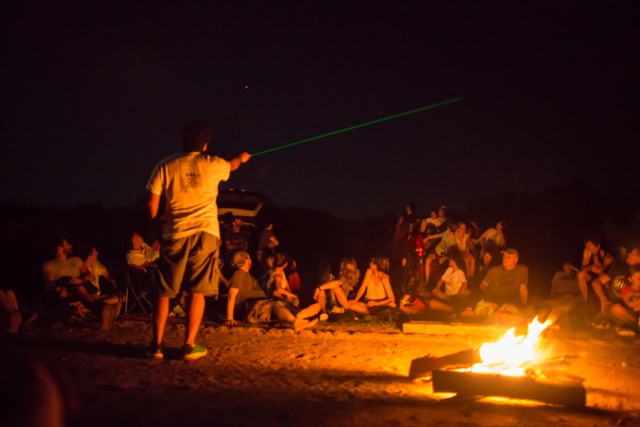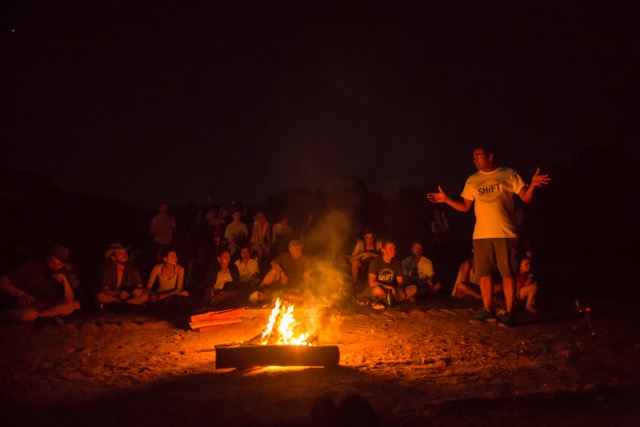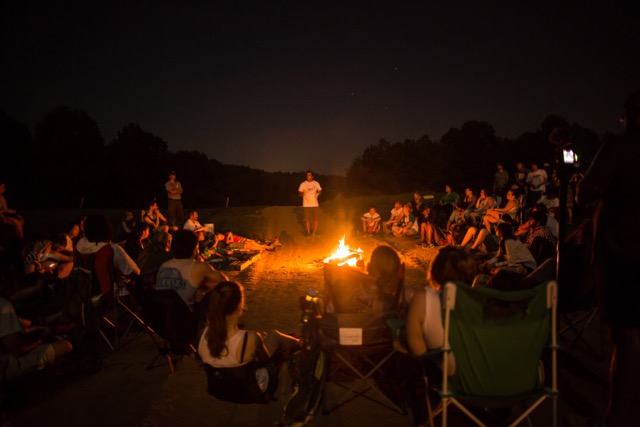
This week, Jeevak was invited to the 2016 SHiFT Design Camp in Tuscumbia, Alabama as one of the keynote speakers. In this unique setting under the canopy of stars, Jeevak was able to speak to a circle of not merely professionals and students, but individually creative humans, their faces softly glowing in the shifting firelight. “It was amazing,” says Jeevak. “It was one of the best speaking experiences ever—literally, under a star filled sky, in front of a sparkling fire. No PowerPoints, no visual cues—just primal, authentic storytelling. It was out of this world!”
The most amazing thing about SHiFT camp is that professionals and students are brought together through its familial atmosphere in a way that few other design experiences can replicate. How is this spellbinding atmosphere made possible? Co-founders Owen Foster, John McCabe, and Tom Gattis created SHiFT Design Camp to be an immersive experience for design professionals and students set in the foothills of the Appalachians. The camp represents a disruption in design education where attendees are removed from the expectations and titles that normally define them as designers.
At SHiFT, attendees learn about design and creativity surrounded only by nature and each other – unplugged. Professionals and students are purposely put on the same playing field. Stripped of superficial barriers, they learn what it is to lead their peers, fail positively, and learn from experience through teamwork, hands-on design challenges, and engaging discussions with thought-leaders in design. They learn together and from each other. After all, as co-founder and director of SHiFT, John McCabe, says “I feel like culturally, when you call somebody a student, you end up putting them below a professional. And the reality is, we should all be, humbly, a student. We want to be a student. If you’re not a student, you act like you know everything. So when we say ‘student’ it’s really for everybody at every level.”




With his audience lounging around the crackling fire, Jeevak asked of them “What’s your element”. Here are the main takeaways from his discussion:
- Find your own constellation.
Jeevak compared the millions of stars visible from where the group was sitting around the fire to the millions of options before each of us in how we use our time and what we make of our lives. The opportunities as well as the distractions are as endless as the stars, and there is no hard and fast answer to how each of us should navigate this “galaxy” of life. However, Jeevak said, we must choose the “stars” or goals that are in the best alignment with who we are individually and what we believe in. In this way we will each trace our own beautiful constellation as we, unique humans, travel through life. Only, don’t follow someone else’s constellation.
- Focus only on your strengths.
Jeevak told the parable of a young rabbit who excels at running in school. However, when he tries flying and swimming, he doesn’t do well for obvious reasons. The problem comes when, instead of focusing on his strengths, the rabbit’s parents refuse to let him run so that he can better focus on improving his flying and swimming skills. In turn, this only makes the poor rabbit depressed and frustrated. Like that rabbit, we will all have weaknesses, but if we know our strengths, we should spend our time cultivating those strengths. By becoming excellent in the things we enjoy and are good at, our strengths will overpower our weakness.
- Be tenacious.
Jeevak told the true story of a Hungarian pistol shooter who was training for the 1940 Olympics when he lost his right arm (the one he shot with) in an army training exercise. Instead of giving up his dream as lost, he went back to training with his left arm. After the disappointment of two cancelled Olympics in 1940 and 1944, he went on to win gold in both the 1948 and 1952 Olympics, shooting with his left arm. As designers, we must take a lesson from him. We should not dwell in the world of facts, but we should explore the world of possibilities. Even when the facts tell us our dreams are improbable, great things are possible when we choose to pursue our goals single-mindedly.
- Embrace your originality.
Each of us can’t help but be original because each of us is unique. There has never been, nor will there ever be anyone exactly like each of us. The world needs each of our specific strengths and perspectives – so we must take responsibility! We can suppress and deny our originality, or we can embrace it, cultivate it, and infuse it into everything we do to the benefit of those around us. We must choose the latter.
- There is ordinariness to goodness.
Great things come about ordinarily. Charles Eames once said, “Choose your corner, pick away at it carefully, intensely and to the best of your ability and that way you might change the world.” Jeevak echoed this truth using the example of the small French town, Le-Chambon-sur-Lignon. During WWII, almost all of the villagers independently made the decision to hide Jewish families who were in need of rescue. They never talked about it to each other, and throughout years of the Nazi army searching the village and questioning villagers, not one of those hidden was found. By the time the war ended however, 5,000 people survived because of the individual conviction of each villager in Le-Chambon-sur-Lignon.
Quietly and consistently doing a good thing is powerful. Confronting a massive problem is not the domain of superheroes. Ordinary people like us can accomplish massive feats when we devote ourselves to a goal every day. For example, if we want to be an amazing sketch artist, we must start sketching every day. Even when we start out very small and build from there, the result will be worthwhile.
- Always be curious and fearless.
We must adopt a default mental state of curiosity. We must always be asking questions to search for the underlying reasons and root causes behind the issues we will confront, and we must not be so afraid of what we will find that we never ask.
- Last, routine is not a bad word.
If we find something that we want to do every day, whether it’s spending time with family, our jobs, hobbies, or whatever, we might find ourselves in a routine, but that doesn’t mean we’re stagnant. It’s also just doing what we love to do! If our life is structured in such a way that we are daily pouring into things we love, and improving our skills, that’s great!
Through the atmosphere created at SHiFT camp including discussions like Jeevak’s, the idea that designers are fundamentally unique and creative humans is brought to the forefront. As designers, whether currently under the professional or student label, let us choose to never become too comfortable in our abilities, or live as though we know everything. But like our friends at SHiFT have taught us, let’s remember to keep a student mindset and as Jeevak said, always stay curious!
More about SHiFT can be found here.